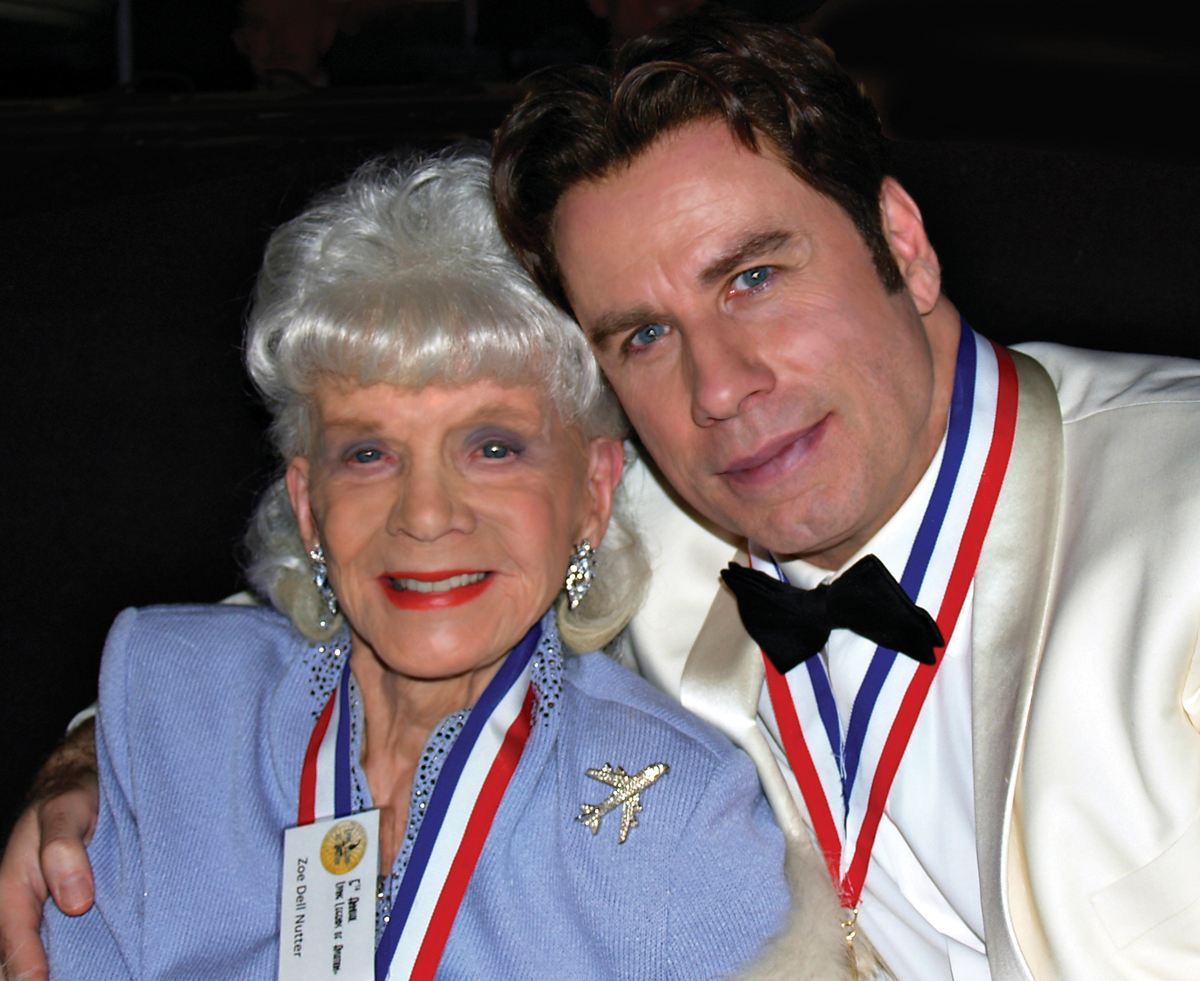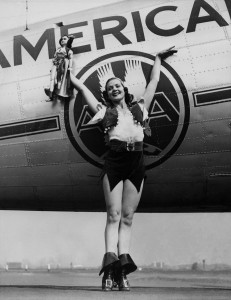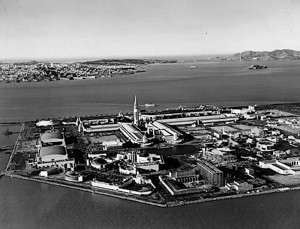By Carol L. Osborne

Living Legends John Travolta and Zoe Dell Lantis Nutter visit during the 5th annual awards ceremony on Jan. 24, 2008, at the Beverly Hilton Hotel. Zoe Dell was recently named the First Lady of Aviation.
Zoe Dell Lantis Nutter’s greatest contributions to aviation were born from her vision and dream that the aviation industry should have its own hall of fame and an annual gathering of aviation legends. In the words of Ohio Gov. George Voinovich, “Because of her, I became interested as a governor in helping her dream become a reality in Ohio. Let me remind you of the names of some of America’s foremost aviation pioneers—the Wright brothers, John Glenn, Neil Armstrong and, yes, Zoe Dell Nutter—Ohioans, one and all.”
Ohio’s partnership with aviation created the National Aviation Hall of Fame (NAHF) in Dayton. In 1988, after serving 12 years on the board of trustees, Zoe Dell was elected its first woman president and chairwoman.
Zoe Dell’s legacy now includes the two most important and prestigious aviation events in the world. She worked tirelessly to see that the U.S. House and Senate recognized Dayton as the “Birthplace of Aviation.” In addition to the solemn enshrinement process of the NAHF, Zoe Dell believed that aviation could benefit from an annual gathering of contemporary aviation legends, recognizing the accomplishments of aviation’s celebrities, entrepreneurs and innovators— a living history and record of aviation’s evolution.
Having spent more than 70 years promoting the industry, Zoe Dell recognized the important role Hollywood celebrities have played in the growth of aviation. Gene Autry, Jimmy Stewart and others used their status to inspire future aviators and increase overall interest. As one of the 70 members of the exclusive Living Legends of Aviation, she suggested that the annual Legends awards ceremony be moved to Beverly Hills and that the event be modeled after the Academy Awards. Her idea would once again take aviation to the next level.
In January 2009, at the 6th annual Living Legends of Aviation awards banquet, Zoe Dell was presented the prestigious Bob Hoover Freedom of Flight Award in recognition for her lifelong dedication to the success of both commercial and general aviation. She was also recently named the First Lady of Aviation by the Legends committee.
|
Aviator, safety activist and corporate executive Promoting commercial airline travel and the 1939/1940 Golden Gate International Exposition (also known as the World’s Fair), Zoe Dell flew more than 100,000 air miles. She learned to fly at a time when women were not encouraged to become pilots. She, however, became a commercial multi-engine pilot and logged more than 2,000 hours. Zoe Dell has flown in competitive aeronautical races and served as an officer in the Civil Air Patrol, where she flew search and rescue missions. As the first woman president of the NAHF, Zoe Dell devoted years of her time and talent to make the organization the success it is today. Always activley involved, she currently serves on boards of the NAHF, Treasure Island Museum and the San Francisco Aeronautical Society. She is also a member of the Ninety-Nines, the International Organization of Licensed Women Pilots, and works as a mentor in a military-based program. |
Zoe Dell is a successful businesswoman, a member of the board of trustees of Ford’s Theater in Washington, D.C., and a charter member of the Friends of the First Ladies of the Smithsonian. Her deep commitment to flight was recognized by President Bush in June 2006. Duing the President’s Reception event, Zoe Dell was awarded the Ford Theater’s Lincoln Medal.
Former First Lady Laura Bush described Zoe Dell to the audience as she presented her with the award, saying, “Few women can claim to be a dancer, a model, a huntress, an aviator, a philanthropist and a pirate. But tonight’s honoree, Zoe Dell Lantis Nutter, is one of them … Zoe Dell has always loved the stage, whether dancing as a chorus girl, pirouetting in the San Francisco Ballet or performing her most visible role, the official pirate theme girl for the 1939/1940 Golden Gate International Exposition held on San Francisco’s Treasure Island.”
The Ford’s Theater board of directors bestowed upon her their highest honor, the Lincoln Medal, because of the contributions she made to the advancement of her chosen profession. Zoe Dell has distinguished herself as one of the greatest supporters of and contributors to the institution.
She never thought of becoming a pilot or being such an influential supporter of the fast-growing aviation industry. In the beginning, her dream was only to become a dancer. The youngest of five, Zoe Dell was born in western Oregon in a mountain lumber camp. Her father had a lumber mill on 40 acres of prime timber. She grew up in the depth of the Depression, and her parents were hard-working, good people. Their strength got the family through some tough times, always together.
In the beginning
Just before her 9th birthday, Zoe Dell spent the summer with an aunt in Seattle. Aunt Hazel entertained her young house guest by sending Zoe Dell to the theater for the day, brown bag lunch in hand. When Zoe Dell returned to her aunt’s each night, she would practice the dance routines she had studied that day. She was in heaven, and that’s when she knew she wanted to be a dancer more than anything.
When her parents moved to Medford, Ore., she was fortunate enough to move next door to a dance teacher. Mrs. Lantis did not support her daughter’s dreams of performing. She felt Zoe Dell needed a formal education, not formal dance training. Luckily for Zoe Dell, the neighbor agreed to give her dance lessons in exchange for washing dishes and doing housework on the weekends.
Zoe Dell worked hard for those lessons and eventually became an assistant to her dance teacher. She played in recitals and earned money at any opportunity. By age 17, Zoe Dell had graduated from high school and was ushering and cashiering at the local theater. When she turned 18, she had saved $100. She packed her bags and headed for San Francisco.
When she got off the train in Oakland, Zoe Dell took the ferry to San Francisco and checked her bag at the Ferry Building. She walked up Market Street and put her application in at three major theatres—she received offers from all of them. She chose the one that hosted stage shows and started as an usherette the next day. For the next two months, Zoe Dell went to the theater early to watch rehearsals. That’s when she decided to switch to the nightclub shift so she could take ballet classes during the day.
From ballerina to pirate girl
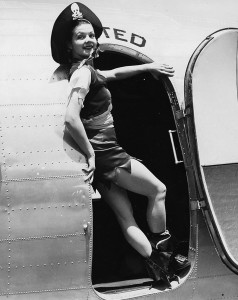
As the World’s Fair’s spokeswoman, Zoe Dell also promoted the use of commericial airplanes for travelling to the event. Here she poses for United Airlines.
When she wasn’t working as an usherette, Zoe Dell was travelling across the country with the San Francisco Ballet. After three years in the theater and working the nightclub circuit, Zoe Dell quit her “day job”, hired an agent and performed specialty numbers (or solo acts) in the theater. She continued to learn from the best like Mr. Bojangles, who taught her the “stair-step-tap” routine that made Shirley Temple famous.
From 1937 to 1940, Zoe Dell performed as principal dancer for the San Francisco Ballet. While performing in a show at the St. Francis Hotel in San Francisco, someone from Treasure Island went backstage to ask if she would be interested in promoting the 1939 Golden Gate International Exposition as its theme girl. The job required travelling all over the country by plane to promote the Fair and air travel in general.
At that time, commercial airlines were flying nearly empty aircraft, and Zoe Dell’s job was to encourage tourists to fly to the World’s Fair. The Fair’s representative told her, “After what I just saw you perform, we know you can dance, flip, spin and jump, and we are sure you won’t get airsick.” He told her that she could learn everything else. Zoe Dell said, “It took me two seconds to agree to take the job!”
Standard Oil was a major sponsor of the Fair. Their publicity representative, Ted Huggins, was in charge of publicity and promotion for the event. It was his idea to build Treasure Island as an international airport for the flying boats. He thought the event could also be promoted as a way to celebrate the completion of the new San Francisco bridges.
“Public perceptions in the 1930s and 40s was that flying was dangerous. Flight attendants were required to be registered nurses, and that message didn’t give the public much confidence in flying by commercial airlines,” Zoe Dell explained. “I never got airsick and never worried about my safety flying through rough air and turbulent weather. In fact, in all my years of flying, I’ve never lost my lunch or my luggage.”
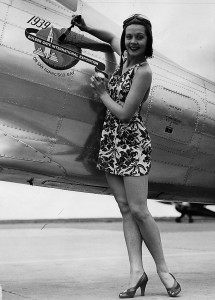
Zoe Dell Lantis puts finishing touches on the 1939 Golden Gate Int’l Exposition emblem on the plane of Frank W. Fuller, Jr., the air speed king named chief pilot of the Exposition. Fuller went on to attempt a series of city-to-city flight records.
Her first flight as the pirate theme girl was to Seattle. The January weather was cold, especially in just her costume. After being photographed all day, Zoe Dell was cold, hungry and had just sat down to eat when her name was called. It was the first time she had to give her “World’s Fair” speech.
Since she had been to Seattle as a young girl, she was able to say a few words that resonated with the audience as she invited the people to the Fair and encouraged them to come by air. Afterwards, they wired her boss to tell him what a wonderful job she had done. From then on, the job of public relations and speaking was all hers.
The world’s “Most Photographed Girl”
Zoe Dell made national headlines in 1939 as Treasure Island’s pirate girl as she promoted aviation from coast-to-coast. Life magazine featured her in its Feb. 7, 1938 issue, and the National Clipping Service named her the “Most Photographed Girl in the World.” She visited the governors of each state and the mayors of most U.S. cities that had airports. Zoe Dell invited the public officials and their citizens to travel to San Francisco by commercial airlines and visit the Fair.
As a pirate from Treasure Island, her theme girl role was a a sensational success. Working closely with E. Carl Wallen, photographer for the Fair, she invented promotional ideas and photo shoots to entice the public to the Fair. Her visit to New York’s colorful mayor Fiorello LaGuardia was especially publicized because he was startled by Zoe Dell’s pirate costume.
It was “skimpy” by 1938’s standards, and the mayor had just cleand up New York city, banishing burlesque. He refused to be photographed with Zoe Dell in her outfit because he thought she might be part of a set-up. So Zoe Dell dawned a fur coat for her visit to his office to present him with a formal invitation to the Fair.
Zoe Dell was in the public eye, and she shared the spotlight with several future actors, aviators and performers who launched their careers while working to promote the World’s Fair on Treasure Island, including
• Douglas “Wrong Way” Corrigan, an American aviator who applied to (and was declined by) the CAA for permission to fly across the Atlantic. But Corrigan successfully flew from New York to Ireland in 1938, claiming his unauthorized flight was a navigational error. After that, Corrigan and his airplane gathered a crowd wherever they went.
• Art Linkletter worked as a radio director on Treasure Island. He later delighted many growing up in the 1950s and 60s with his TV programs “Kids Say the Darndest Things,” “House Party” and “People Are Funny.” Zoe Dell and Linkletter maintain their long friendship with an occasional lunch. He is 97 years old and lives in southern California.
• Joe Rosenthal was also on Treasure Island. He’s the American photographer who received a Pulitzer Prize for his historic WWII photograph “Raising the Flag on Iwo Jima.” In late 1939, one of Rosenthal’s first assignments was to work as an AP San Francisco photographer on Treasure Island. He captured all the events and Zoe Dell. “Joe was exceptionally good at taking action shots,” remembered Zoe Dell. “In those days, it was hard to get a good action shot because the old 4 x 5 speed graphic cameras were so bulky.”
Rosenthal and Zoe Dell worked together and became good friends. They stayed in touch for almost 70 years until his death in 2006.
Marrying a dentist
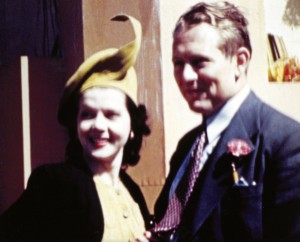
Zoe Dell with friend Art Linkletter after just completing the first televised closed circuit interview.
Zoe Dell Lantis met her first husband, Dr. Richard S. West, at the close of the Fair. He was working part-time and was a dental school intern. West’s job was to care for the dental needs of the Fair’s performers. After a short courtship, the two were married, and West went into private practice.
Right after Pearl Harbor was attacked, West joined the Army Air Corps and was assigned to the largest regional station hospital in Santa Ana, Calif. The couple had only been in southern California a short time when Zoe Dell’s doctors told her she needed back surgery. This was devastating news because it meant her dance career was over, and she had wanted to join the USO and go on tour to support her country. Now that was impossible.
One of her good friends, John T. “Bucky” McGeoghegan, and his wife Grayce, played in a dance band that Zoe Dell knew. They had taken up flying, and Bucky was working toward a career in aviation. During the war, he was a transport pilot, and afterwards he became a Pan American Clipper pilot. Bucky and another aviation friend encouraged Zoe Dell to pursue flying. While her husband was waiting for his next assignment, he was transferred to Las Vegas, where they both earned their basic ratings.
Learning to fly
One sunny day, when she was waiting her turn to fly, Howard Hughes approached Zoe Dell’s plane. He was very friendly and encouraged her to fly in a Powder Puff Derby to gain experience and credibility in the aviation community.
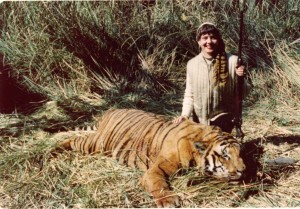
Zoe Dell went on safari in India with her husband, Erv, and his son, Bob. The family went on many safaries together, including some trips to Africa. Seen here in India, Zoe Dell had to defend herself against a tiger that attacked from the tall grasses.
After the war, the Wests moved to northern California, where it could take three hours to drive to San Francisco on the two-lane highway, locally known as “Slaughter Alley” because of the horrible accidents on it in the days before seatbelts. Zoe Dell’s husband had a growing practice stemming from soldiers injured in the Pacific. Now his skills were called upon for reconstructive dentistry due to all the accidents on Slaughter Alley.
To skip the long, dangerous drive to San Francisco, Zoe Dell joined a flying club. The club was comfortable with having two women as members. As Zoe Dell said, “We had use of everything in the club from A to Z.”
The men didn’t use the planes during the day, so Zoe Dell often flew to San Francisco to go shopping. She would get dressed up in furs, heels and jewelry,and would fly into the city in 45 minutes. “I could leave home at 9 a.m., and be in downtown San Francisco shopping by 10.”
In 1958 she and West divorced. That same year, she was asked by Standard Oil to be the official representative (or Ambassador-tress) to the World’s Fair in Brussels, Belgium. She visited countries around the world, meeting and inviting world leaders to the Fair and, of course, promoting commercial air travel.
As Zoe Dell was travelling around the globe meeting politicians, it sparked an intense interest in politics that drives her to this day. The Republican party asked Zoe Dell to run for the northern California legislature, but she opted to serve on the State Central Committee to elect Ronald Reagan to the governorship and later the presidency.
The Father of General Aviation and the 99s
By the early 1960s, Zoe Dell was promoting general aviation as well. William T. Piper, president of Piper Aircraft, offered her a position at Monarch Aviation (Piper Aircraft’s FBO and flight school) in Monterey, Calif. She adored Piper and considered him “The Father of General Aviation.” Zoe Dell worked for Piper marketing and demonstrating his airplanes and selling flight courses. Zoe Dell and three other women pilots in Monterey started the Monterey Chapter of the Organization of Licensed Women Pilots, the Ninety-Nines.
Pinch hitting and a new trainer
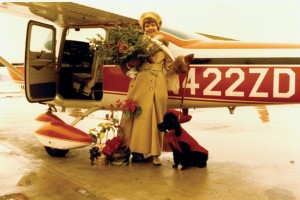
Here is Zoe Dell with her poodle. She regularly put C’est Si Bon on the cowling while she preflighted the airplane. This way her little companion was out of the way of other planes.
Zoe Dell was promoting the “Pinch Hitter” course, which taught women how to land a plane in case of an emergency. Zoe Dell encouraged women across the aviation community to learn how to land a plane, use the radio and read navigational charts.
In the early 1960s, general aviation was growing so quickly that the market was seeking an inexpensive trainer that would be ideal for student instruction. The trainer up for consideration was a Bede-1. It was in high demand across the country, although it had not been FAA-certified.
Zoe Dell was sent to Dayton to put a deposit down on the Bede-l and get Monarch Aviation’s name on the list. When she left Monterey, her boss told her that she might not have a job when she returned if she didn’t bring back a new Bede-l. It was on this trip that she met a successful Dayton businessman, Ervin J. “Erv” Nutter, who was destined to be her husband. Erv told Zoe Dell that he had a friend who knew Mr. Bede himself and that he might be able to help her purchase the plane.
Erv took her to Springfield, Ill., where Bede Aircraft was located. After Zoe Dell studied all aspects of the Bede-1, she felt that it was not a safe trainer aircraft. It was an innovative concept, with the wings pulled out from the side of the fuselage, folded to the back and locked securely in place by small levers under the plane. At this point, the plane was ready to be towed behind a car or moved to a garage for storage. Zoe Dell couldn’t see anybody exposing an airplane to the elements of the freeway and felt the plane could be easily damaged.
Monarch then sent Zoe Dell to Vero Beach, Fla., where she picked up a conventional trainer (a four-place Cherokee 140) and flew it back to Monterey.
A wife and corporate executive, again
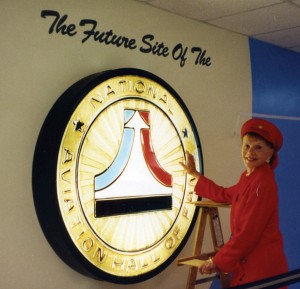
Zoe Dell worked tirelessly to have the new NAHF located within Wright Patterson AFB Museum. Here is Zoe Dell displaying “The Future Site of The NAHF” in July 1995.
After a whirlwind courtship, Zoe Dell married Erv Nutter, CEO and president of Elano Corporation.
During WWII, Erv was selected by his professor in the University of Kentucky’s engineering department for a position at Dayton’s Wright Field, one of the most important aviation research and development laboratories operated by the U.S. government.
Erv rose the ranks quickly at Wright Field and was soon the only civilian test branch chief in the laboratory. He oversaw the environmental testing of military aircraft , including the technology of enemy aircraft. He was a member of “The Manhattan Project,” building and testing the trigger mechanism for the atomic bomb.
While serving as an Army Air Corps designer, builder and chief of the test lab, Erv’s work helped define the cutting edge of modern aviation. Few in the field studied the bending of tubes, the flow of fluids, and the temperature and pressures of exotic metals. Most had no interest in this technology, but Erv knew it was going to be that technology that would be critical for constructing jet engines.
Elano Corporation was formed in 1950 by Erv Nutter and his partner, Lee A. Otterson. They scrambled the initials of their names to create the corporate name Elano. It has grown to be one of the most successful manufacturers of castings, piping, precision-bent tubing and various other components used by the aerospace industry. Elano grew from three employees in 1950 to nearly 600 in 1985 when the company was sold to General Electric.
Exploring the world: Family safaries to Africa and India

Zoe Dell and Erv Nutter (back row) with Horace Wright (nephew of the Wright brothers) Susan Wright (Horace’s wife), Ivonette Wright Miller (niece of Wright brothers; she actually flew with Orville) and Harold S. Miller (Ivonette’s husband, a Daedalian).
Zoe Dell attained her commercial rating while dating Erv. When the couple got married and moved to Dayton, Zoe Dell had just turned 50. As she put it, “I thought I was very old, but I had no idea I was just beginning to live. If I could live my life over, it’d be from 50 on.”
Zoe Dell moved to the Nutter ranch in Dayton, where she still lives. She became wife and step-mother to three sons, all in school. The youngest was 12. She decided to run the home, pursue her passion for flying and get her instrument and multi-engine ratings.
Zoe Dell took her aviation training seriously. She went to Chicago for instrument training at Midway because it was known as the toughest school in America. Zoe Dell encouraged Erv to become a pilot so they could enjoy flying together.
Even though Zoe Dell had more hours in the air, Erv knew a great deal more about engines and their performance—the combination worked well for the pair.
In 1965, the Nutters went on the adventure of a lifetime—a hunting safari to Africa. It was Zoe Dell’s first safari, and she was instantly in love with the experience. She has now been a member of the exclusive Shikar-Safari International organization for 52 years.
The Wrights’ legacy
When Zoe Dell arrived in Dayton, she was surprised to learn that hardly any recognition was given to the Wright family. She thought the Wright brothers’ legacy should be shared with the world. She made sure the Wrights’ living relatives (niece Ivonette Wright Miller and nephew Horace Wright) were honored along with their famous uncles at aviation events across the U.S.
Recently, she nominated Amanda Wright to the Living Legends of Aviation. Great grandniece of the Wright brothers, Amanda Wright Lane and her brother, Steven, manage the family home, Hawthorn Hill, which is designated as a National Treasure and is property of the Department of the Interior.
Zoe Dell and Erv personally knew some members of the Wright family. Erv actually knew Orville Wright, who lived in Dayton until he passed away in 1947. Katherine Wright, sister and silent partner, lived at Hawthorn Hill with their father, Bishop, Orville and their mother. Wilbur died in 1912 of typhoid fever while building the family homestead. Wilbur assisted with the design, but unfortunately never had the chance to live there.
Aviation’s Birthplace
Dayton is where aviation began, the home of Wilbur and Orville Wright. After accomplishing the first lift-off at Kitty Hawk, N.C., the brothers returned to Ohio and taught themselves and the world to fly. Turn and bank originated in Dayton along with the Wrights’ wind tunnels and and their forward-thinking technology. Their beautiful home and company rested in Dayton and is now overseen by their great grandniece and nephew, Amanda Wright Lane and Steven Wright.
Marketing, the greatest small business manifold
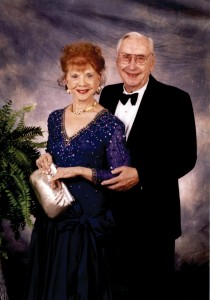
Zoe Dell and Erv Nutter loved to fly together. Erv admired his wife’s dedication to and passion for aviation. They attended many industry events to show their support of the future of aviation.
Zoe Dell always encouraging her husband as he tackled special projects. When he had an engineering problem, she served as a sounding board, and the two would work long hours, well into the night. Zoe Dell understood the value of engineering and manufacturing of aircraft parts as well as the marketing of the finished product. She was a valuable resource for Erv.
One of Zoe Dell’s lesser-known accomplishments is the development of the Elano manifold. During earlier flights in California, her plane needed more power to get over the mountain range. After talking to her husband, a few Elano engineers were assigned to design a better exhaust manifold using stainless steel. From that endeavor, the Elano manifold was developed and certified, and it has become OEM standard equipment on many piston aircraft.
National Aviation Hall of Fame chartered by Congress
Zoe Dell became involved with the NAHF soon after attending her first Enshrinement ceremony in 1966, and she hasn’t missed one since. In those early days, there were more people in the ceremony than in the audience. Few women attended, maybe one or two (a wife of someone), but it was a “Good Ol’ Boys’ Club.” Zoe Dell remembered, “The men would take you and go off and ‘hangar fly,’ and you’d just stand around.”
Things began to shift, and women took on a key role in the development of aviation. By the late 1960s, several NAHF board members came to Zoe Dell’s home to ask for her help in building the organization. She offered to do what she did best—work on the promotion of the NAHF through public relations efforts like hosting benefit luncheons and coordinating every detail. She also worked to increase attendance by women, even the wife of her state’s Congressman.
To get them excited about her cause, Zoe Dell showed them videos of NAHF ceremonies and reinforced the important role aviation and its enthusiasts played in the world’s economy. Over a period of years, with Zoe Dell’s help, NAHF developed a larger audience and increased membership.
In 1988, after serving 12 years on the board, Zoe Dell was elected the first woman president and chairwoman of the Congressional NAHF. Of all her great accomplishments, she is most proud of using her promotional skills and aviation knowledge to develop and lead the official NAHF.
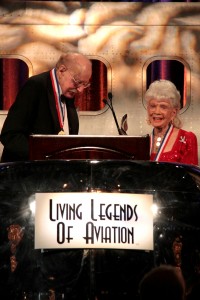
Zoe Dell was honored in 2009 at the 6th annual Living Legends of Aviation ceremony with the prestigious Bob Hoover Freedom of Flight Award.
The NAHF honors four individuals each year that have excelled in aviation and contributed to its success during his or her lifetime. Some of those honored are enshrined posthumously. As important as the NAHF is to Zoe Dell, she added, “I believed it was also important for the Living Legends of Aviation to meet together, to recognize significant contributions to aviation as they happened. With the benefit of celebrity exposure and a Hollywood venue, the Living Legends of Aviation annual awards ceremony is a spectacular opportunity to promote aviation and recognize people of extraordinary accomplishment.”
Zoe Dell visited our nation’s capitol many times to meet with elected officials about concerns of NAHF members. Because she was so effective with legislators, she was elected to the board of Ford’s Theater in Washington, D.C. During this time, she met the Secretaries of the Interior, many senators and congressmen, a number of presidents and all the people who produced the shows at the theater. After 22 years with Ford’s Theater, Zoe Dell developed connections which have helped her further promote aviation and the NAHF at the national level.”
Zoe Dell developed many special friendships over the years. One was with Bill Patterson, the founder of United Airlines. “I did a lot of tours for him, and he was enshrined in the National Aviation Hall of Fame. I said, ‘Tell me, Mr. Patterson, if you remember me from the promotional work I did from 1937 to 1940 for the World’s Fair in San Francisco?'”
Zoe Dell said that he replied, “Yes, I remember you.”
She told him that he always sent her to Cleveland. “Why didn’t you send me to Dayton?” she asked.
He replied, “Well, lady, I’ll tell you what I was doing. I was developing an industry and not a history lesson.” He laughed, and Zoe Dell said, “That’s fair enough.”
Eddie Rickenbacker, Jackie Cochran, and many more legendary aviators would come—Zoe Dell remembers them as the mostwonderful events.

Official White House photograph taken June 25, 2006, in the East Room at the President’s Reception. Former First Lady Laura Bush and President George W. Bush honored the tireless efforts and contributions of aviation advocate Zoe Dell Lantis Nutter.
“Juan Tripp of Pan Am was a delight. I really got to be well-acquainted with him. I was his hostess for the Hall of Fame when he came to be enshrined. It was after that they decided they wanted me to be on the board because I knew these people and could sit and talk with them, remembering their achievements, background and history.”
Zoe Dell has also had the extraordinary generosity to make her aviation dreams come true. Thanks to her vision, our country has a restored Ford’s Theater, the NAHF and the Living Legends of Aviation,the most exciting and prestigious aviation event in the world. It is all thanks to a little girl with big dreams.
Zoe Dell has great appreciation for our country’s many freedoms, the free enterprise system and all the wonderful opportunities it affords. Her mission is to protect business aviation and promote it as being practical and safe. Zoe Dell’s motto? “The most dangerous part of your flight is your trip to the airport!”
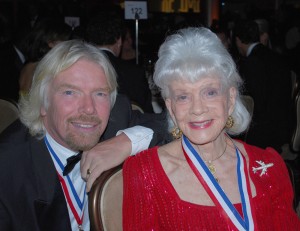
Sir Richard Branson and Zoe Dell enjoyed time together at the 6th Annual Living Legends of Aviation in Beverly Hills.











